In this document you can find information about Security Scanner Tool, such as Scan and rule configuration and more.
The Security Scanner tool scans/checks objects in a Knowledge Base looking for potential security issues according to OWASP's Top 10 Security Risks.
You can open the Security Scanner Configuration Window by selecting the following options from the GeneXus IDE toolbar: Tools > Security > Security Scanner.
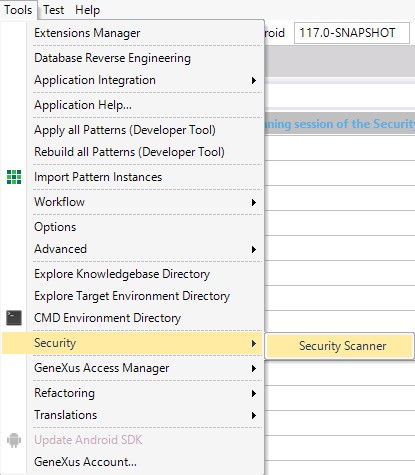
Also, you can apply it to a particular object or a subset of them using the "Security Scanner" Context Menu:
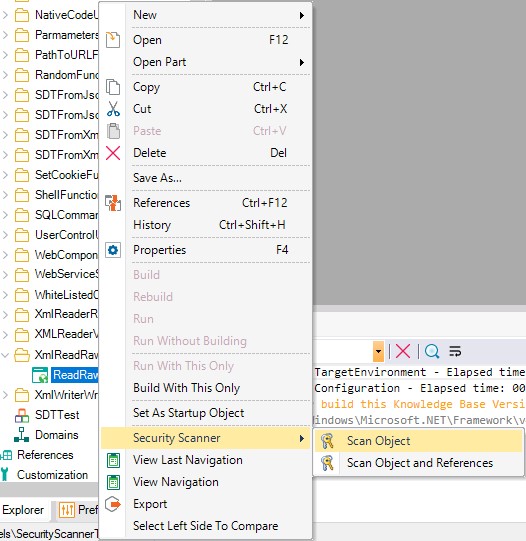
The Environment rules will be applied only when a full scan is triggered. When a partial scan is executed (using the Context Menu) the Environment rules will not be applied.
The tool will scan the following types of objects:
The tool will not scan the following types of objects:
- Referenced module objects
- Unit test objects
When the scan is performed using the IDE, the result will be shown on a new Output Section called Security Scanner.

For every rule, you can configure its severity level or disable it in the Configuration Window.
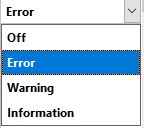
Security Scanner analyzes objects to check if their parameters are encrypted; that is, if their Encrypt URL parameters property is set to "Session key" or "Site key."
If a <Parameter encryption> issue is found, Security Scanner will show the following message:
error: Code: 100 - Parameters encryption property is not set
Security Scanner analyzes attributes, variables, and textblocks checking if their Format property (for Web) has been set to "HTML" or "Raw HTML."
If an <HTML format> issue is found, Security Scanner will show a message like this:
error 101: HTML Textblock detected in WebForm (Name 'htmltxtblock' Type 'HTML'. Name 'rawhtmltxtblock' Type 'Raw HTML'. )
or
error: Code: 101 - Attribute Format allows HTML
Security Scanner analyzes Web Panels and Transactions in the KB checking if they call an Authorization program (procedure). This rule does not apply to Master Pages and Web Components.
If an <Authorization> issue is found, Security Scanner will show a message like this:
error: Code: 102 - No access control configured for this object
When using Xev2, the Integrated Security Level property is checked (GeneXus Access Manager (GAM) usage).
Security Scanner analyzes KB objects looking for SQL commands.
If a <SQL Command> issue is found, Security Scanner will show a message like this:
error: Code: 103 - SQL Command usage found
i.e.: SQL UPDATE UserInfo SET UserWelcomeMessage='[!&UserWelcomeMessage!]' WHERE UserId=[!&UserId!]
Security Scanner analyzes KB objects to check if there is a dynamic command link without parameters.
If a <Link command> issue is found, Security Scanner will show a message like this:
error: Code: 104 - Parameterless LINK command usage found
i.e.: Link(&SomeWebPanel)
Security Scanner analyzes Web Panels and Procedures checking if HTTPS protocol has been specified. This means checking if the Protocol specification property has been set to “Secure (HTTPS).”
In the case of a SOAP Procedure, it will inherit the protocol specification from the environment so it will trigger the rule when an insecure protocol specification is configured in the environment. This applies since GeneXus 17 upgrade 4.
If an <Http protocol> issue is found, Security Scanner will show a message like this:
error: Code: 105 - HTTP protocol is not Secure
or
error: Code: 105 - Protocol Specification is set to 'Do not specify' HTTP protocol is not Secure
Security Scanner analyzes the Javascript debug mode property at generator level; when enabled, the following message will be displayed:
error: Code: 106 - Javascript debug mode is enabled
Security Scanner analyzes KB objects set as Web Components checking if URL Access for them has been enabled. This means checking if the URL Access property has been set to “Yes.”
If a <WC URL Access> issue is found, Security Scanner will show a message like this:
error: Code: 107 - Web Component with URL Access enabled
Security Scanner analyzes KB objects' source section checking for the Java or C-Sharp command.
The following message is displayed:
error 108: Native Code usage found in source
Security Scanner analyzes KB objects' variables section checking for HttpResponse data type usage.
The following message is displayed:
error: Code: 109 - HttpResponse Data Type usage in variables Name 'HttpResponse' Type 'HttpResponse'
Security Scanner analyzes KB objects' source section checking for LDAPClient Data Type GetAttribute method usage.
The following message is displayed:
error: Code: 110 - LDAPClient.GetAttribute function usage
Security Scanner analyzes KB objects' variables section checking for Directory data type usage.
The following message is displayed:
error: Code: 111 - Directory Data Type usage in variables Name 'Directory' Type 'Directory'
Security Scanner analyzes KB objects' variables section checking for File data type usage.
The following message is displayed:
error: Code: 112 - File Data Type usage in variables Name 'File' Type 'File'.
Security Scanner analyzes KB objects' source section checking for XMLReader Data Type ValidationType property usage.
The following message is displayed:
error: Code: 113 - XmlReader Validation type property misconfiguration
Security Scanner analyzes KB objects' source section checking for Shell function usage.
The following message is displayed:
error: Code: 114 - Shell function usage found
Security Scanner analyzes KB objects' source section checking for Random function usage.
The following message is displayed:
error: Code: 115 - Random function usage found
Security Scanner analyzes KB objects' source section checking for SetCookie function usage.
The following message is displayed:
error: Code: 116 - SetCookie function usage found
Whenever possible, use the Cookie data type and enable the HttpOnly property.
Security Scanner analyzes the source section of WebPanels and Transactions checking for Form.HeaderRawHTML property usage.
The following message is displayed:
error: Code: 117 - HeaderRawHTML property usage found
Security Scanner analyzes the source section of WebPanels and Transactions checking for Form.JScriptSrc property usage.
The following message is displayed:
error: Code: 118 - JScriptSrc property usage found
Security Scanner analyzes the source section of WebPanels and Transactions checking for IsPassword property usage.
The following message is displayed:
error: Code: 119 - IsPassword property usage found
Security Scanner analyzes KB objects' source section checking for External Object usage.
The following message is displayed:
error: Code: 120 - External Object usage in variables Name 'CustomType' Type 'CustomType'.
For Xev2; GAM and GXflow External Objects are excluded.
Security Scanner analyzes the WebForm section of Web Panel and Transaction for User Controls usage.
The following message is displayed:
error: Code: 121 - UserControl detected in WebFormName 'CustomControl' Type 'CustomControl'.
Security Scanner analyzes KB objects' variables section checking for Cookie data type usage.
The following message is displayed:
error: Code: 124 - Cookie Data Type usage in variables Name 'Cookie' Type 'cookie'.
Whenever possible, enable the HttpOnly property.
Security Scanner analyzes KB objects' source section checking for the XMLWriter WriteRawText method usage.
The following message is displayed:
error: Code: 125 - XmlWriter.WriteRawText function usage
Security Scanner analyzes KB objects' source section checking for the FromXml method - SDT usage.
The following message is displayed:
error: Code: 126 - SDT.FromXml function usage
Security Scanner analyzes KB objects' source section checking for the FromJson method usage.
The following message is displayed:
error: Code: 127 - SDT.FromJson function usage
Security Scanner analyzes KB objects' source section checking for the XMLReader Data Type's ReadRawXML method usage.
The following message is displayed:
error: Code: 128 - XmlReader.ReadRawXML function usage
Security Scanner analyzes KB objects' variables section checking for Blob data type usage.
The following message is displayed:
error: Code: 129 - Blob Data Type usage detected in object Variable: blob
Security Scanner analyzes KB objects' source section checking for the JSEvent method usage.
The following message is displayed:
error: Code: 130 - JSEvent function usage found
Security Scanner analyzes KB objects' source section checking for the SoapHeaderRaw nonstandard function usage.
The following message is displayed:
error: Code: 131 - SoapHeaderRaw property usage found
Security Scanner analyzes KB objects' source section checking for the PathToURL function usage.
The following message is displayed:
error: Code: 132 - PathtoUrl usage found
Security Scanner analyzes KB objects' source section checking for the XMLReader Data Type ReadExternalEntities Property usage.
The following message is displayed:
error: Code: 133 - XmlReader.ReadExternalEntities property usage
Security Scanner analyzes KB objects' source section checking for the FromXmlFile method usage.
The following message is displayed:
error: Code: 134 - SDT.FromXmlFile function usage
Security Scanner analyzes KB objects' source section checking for the FromJsonFile method usage.
The following message is displayed:
error: Code: 135 - SDT.FromJsonFile function usage
Security Scanner analyzes the KB Environment to check if its parameters are encrypted; that is, if its Encrypt URL parameters property is set to "Session key" or "Site key."
If a <Parameter encryption> issue is found, Security Scanner will show the following message:
error: Code: 136 - Parameters encryption is not set
Security Scanner analyzes the KB Environment checking if HTTPS protocol has been specified. This means checking if the Protocol specification property has been set to “Secure (HTTPS).”
If an <Http protocol> issue is found, Security Scanner will show a message like this:
error: Code: 137 - HTTP protocol is not Secure
Security Scanner analyzes the KB Environment checking if SameSite cookie attribute property is configured with the value None.
If that is the case Security Scanner will show a message like this:
error: Code: 138 - SameSite cookie attribute is set to None
Security Scanner analyzes KB objects' source section checking for the usage of the function FromURL on the multimedia data types (Image data type, Audio data type & Video data type).
The following message is displayed:
error: Code: 139 - Multimedia.FromURL function usage

Using this field, you can select objects and rules to be whitelisted on the analysis.
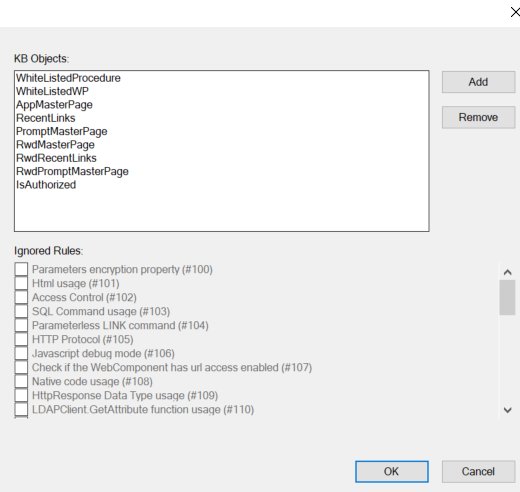
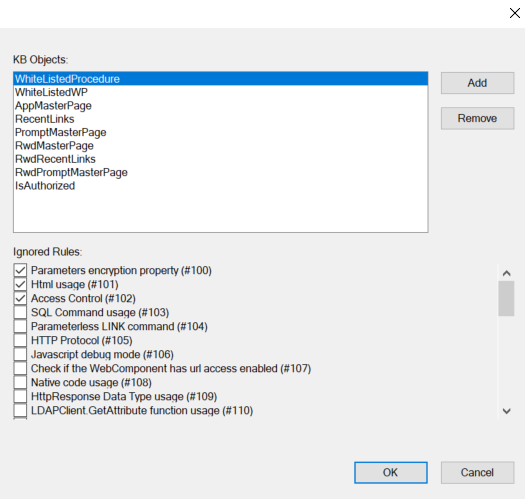

If you are not using GAM, this field allows you to insert a Procedure or Master Page that contains the authorization logic. The scan will show an error for the objects that do not contain the call for the authentication Procedure or use the Master Page selected.
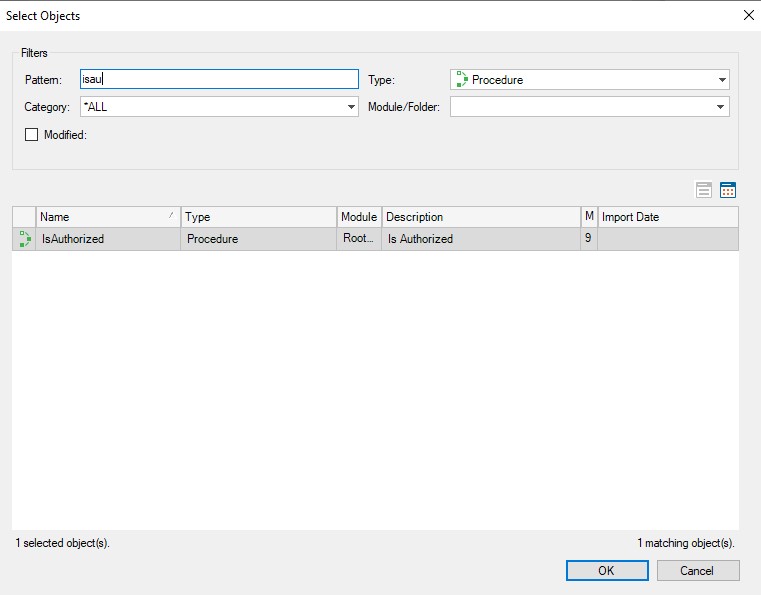
If you put some other type of object (not Master Page and not Procedure), the scan will ignore this configuration.
Define a new Task called Scan that allows you to run the scanner in an MSBuild script. This task can be included in any server-side pipeline of CI/CD.
This task will execute the configuration previously set through the Security Scanner Configuration Window.
<Project DefaultTargets="SecurityScan" xmlns="http://schemas.microsoft.com/developer/msbuild/2003">
<Import Project="$(GXInstall)\genexus.tasks.targets"/>
<Import Project="$(GXInstall)\security.tasks.targets"/>
<Target Name="SecurityScan">
<OpenKnowledgeBase Directory="$(KBDir)" />
<SecurityScan XmlOutputFile="securityTest.xml"/>
</Target>
</Project>
By specifying the XmlOutputFile you get Errors and Warnings in XML format.
msbuild securityscantest.msbuild /verbosity:minimal /t:SecurityScan /p:KBDir=c:\mykbpath /p:GXInstall=c:\genexusinstalldir